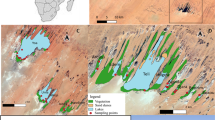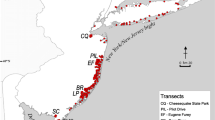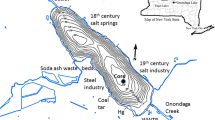Abstract
Diatoms were identified and enumerated from the surface sediments of 65 lakes located on the Cariboo and Chilcotin Plateaux (British Columbia, Canada). These lakes span a large gradient in lakewater ionic concentration (fresh through hypersaline) and composition, as well as other physical/chemical variables. Almost all of the study lakes had higher salinities in the late-summer than in the spring. The lakes with spring salinities >8 g l−1 showed the largest seasonal increases in salinity. Ionic composition was similar in the spring and late-summer for most lakes. Both ionic concentration (i.e. salinity) and composition were important environmental variables that could account for the different diatom floras in the lakes. Diatom assemblages characteristic of carbonate-dominated and sulfate-dominated waters were identified. Other variables such as water depth and phosphorus concentration were also important.
The majority (87%) of diatom taxa had estimated salinity optima < 3 g l−1 Halophilic diatom taxa had broader tolerances to salinity when compared to the fresh water taxa, however taxa with narrow and broad tolerances could be identified across the salinity gradient. Species diversity was weakly but significantly correlated to lakewater salinity (r 2 = 0.18 to 0.3, P < 0.05).
Salinity inference models were developed based on the relationship between the diatom assemblages and the spring, late-summer and average salinity. The correlations between the measured and diatominferred salinity, based on the spring (r = 0.95), late-summer (r = 0.94) and average (r = 0.95) salinity data, are high because there was an extremely strong correlation (r = 0.98) between the log transformed spring and late-summer measured salinities. These salinity reconstruction models provide a tool that can be used to infer past climatic changes as part of paleolimnological studies from appropriate closed-basin lakes in British Columbia.
Similar content being viewed by others
References
American Public Health Association, 1980. Standard Methods for the Examination of Water and Wastewater, 15th edn. Washington, D.C.
Birks, H.J.B., S. Juggins & J.M. Line, 1990a. Lake surface-water chemistry reconstructions from palaeolimnological data. In B.J. Mason (ed.), The Surface Waters Acidification Programme. Cambridge University Press, Cambridge: 301–313.
Birks, H.J.B., J.M. Line, S. Juggins, A.C. Stevenson & C.J.F. ter Braak, 1990b. Diatoms and pH reconstruction. Phil. Trans. r. Soc. Lond. B 327: 263–278.
Bradbury, J.P., R.M. Forester & R.S. Thompson, 1989. Late Quaternary paleolimnology of Walker Lake, Nevada. J. Paleolimnol. 1: 249–267.
Camburn, K.E., J.C. Kingston & D.F. Charles (eds), 1984–1986. PIRLA Diatom Iconograph. Report No. 3. PIRLA Unpublished Report Series, 53 photographic plates, 1059 figures. Dept. of Biology, Indiana Univ., Bloomington, IN.
Cumming, B.F, J.P. Smol & H.J.B. Birks, 1992. Scaled chrysophytes (Chrysophyceae and Synurophyceae) from Adirondack drainage lakes and their relationship to measured environmental variables. J. Phycol. 28: 162–178.
Eugster, H.P. & L.A. Hardie, 1978. Saline Lakes. In A. Lerman (ed.), Lakes: Chemistry, Geology, Physics. Springer-Verlag, New York: 237–293.
Fontes, J. C. & F. Gasse, 1991. PALHYDAF (Palaeohydrology in Africa) program: objectives, methods, major results. Palaeogeogr. Palaeoclimatol. Palaeoecol. 84: 191–215.
Fritz, S.C., 1990. Twentieth-century salinity and water-level fluctuations in Devils Lake, North Dakota: Test of a diatom based transfer function. Limnol. Oceanogr. 35: 1771–1781.
Fritz, S.C. & R.W. Battarbee, 1988. Sedimentary diatom assemblages in freshwater and saline lakes of the Northern Great Plains, North America: preliminary results. In F.E. Round (ed.), Proceedings of the 9th International Diatom Symposium. Koeltz Scientific Books, Koenigstein: 265–271.
Fritz, S.C., S. Juggins, R.W. Battarbee & D.R. Engstrom, 1991. Reconstruction of past changes in salinity and climate using a diatom-based transfer function. Nature 352: 706–708.
Fritz, S.C., S. Juggins, & R.W. Battarbee. 1993. Diatom assemblages and ionic characterization of lakes of the northern Great Plains, N.A.: A tool for reconstructing past salinity and climatic fluctuation. Can. J. Fish. aquat. Sci. (in press).
Gasse, F., 1983. Diatom assemblages in East Africa: classification, distribution, and ecology. Revue. Hydrobiol. trop. 16: 3–34.
Gasse, F., J.C. Fontes, J.C. Plaziat, P. Carbonel, I. Kaczmarska, P. De Decker, I. Soulié-Märsche, Y. Callot & P.A. Dupeuble, 1987. Biological remains, geochemistry and stable isotopes for the reconstruction of environmental and hydrological changes in the Holocene lakes from North Sahara. Palaeogeogr. Palaeoclimatol. Palaeoecol. 60: 1–46.
Germain, H., 1981. Flore des diatomées: Diatomophycées. Société Nouvelle des Éditions Boubée, Paris, 444 pp.
Glew, J. R., 1991. Miniature gravity corer for recovering short sediment cores. J. Paleolimnol. 5: 285–287.
Håkansson, H., 1986. A taxonomic reappraisal of some Stephanodiscus species (Bacillariophyta). Br. Phycol. J. 21: 23–47.
Håkansson, H. & E.F. Stoermer, 1984. Observations on the type material of Stephanodiscus hantzschii Grunow in Cleve & Grunow. Nova Hedwigia 39: 477–495.
Hall, R.I. & J.P. Smol., 1992. A weighted-averaging regression and calibration model for inferring total phosphorus concentration from diatoms in British Columbia (Canada) lakes. Freshwat. Biol. 27: 417–434.
Hill, M.O., 1973. Diversity and evenness: a unifying notation and its consequences. Ecology 54: 427–432.
Hill, M.O. & H.G. Gauch, 1980. Detrended correspondence analysis, an improved ordination technique. Vegetatio 42: 47–58.
Hustedt, F., 1927–1966. Die Kieselalgen Deutschlands, Österreichs und der Schweiz. In Dr. L. Rabenhorst's Kryptogamen-Flora von Deutschland, Österreich und der Schweiz, Akademische Verlagsgesellschaft, Leipzig 3 Vols.
Jeffery, D.A., 1989. Laboratory Quality Assurance Manual. Zenon Environmental Inc., Burnaby, 34 pp.
Kolbe, R.W., 1927. Zur Ökologie, Morphologie und Systematik der Brackwasser-Diatomeen. Pflanzenforschung 7: 1–146.
Krammer, K. & H. Lange-Bertalot, 1986–1991. Bacillariophyceae. Sü\wasserflora von Mitteleuropa, Band 2 (1–4). Gustav Fischer Verlag, Stuttgart 4 Vols.
Mathews, W.H., 1986. Physiography of the Canadian Cordillera. Geol. Surv. Can., Map. 1701A (1:5,000,000).
Patrick, R., & C. Reimer, 1966–1975. The diatoms of the United States exclusive of Alaska and Hawaii. The Academy of Natural Sciences Philadelphia, Philadelphia, 2 Vols.
Renaut, R.W. 1990, Recent carbonate sedimentation and brine evolution in the saline lake basins of the Cariboo Plateau, British Columbia, Canada. Hydrobiologia 197: 67–81.
Renaut, R.W. & P.R. Long, 1987. Freeze-out precipitation of salts in saline lakes — examples from Western Canada. In G.L. Strathdee, M.O. Klein & L.A. Melis (eds), Crystallization and precipitation. Pergamon, Oxford: 33–42.
Renaut, R.W. & P.R. Long, 1989. Sedimentology of the saline lakes of the Cariboo Plateau, Interior British Columbia, Canada. Sed. Geol. 64: 239–264.
Servant-Vildary, S., 1986. Les diatomées actuelles des Andes de Bolivie (Taxonomie, écologie). Cah. de Micropaléontol., CNRS, 1, 3–4: 99–124.
Servant-Vildary, S & M. Roux, 1990. Multivariate analysis of diatoms and water chemistry in Bolivian saline lakes. Hydrobiologia 197: 267–290.
Smol, J.P., 1981. Problems associated with the use of ‘species diversity’ in paleolimnological studies. Quat. Res. 15: 209–212.
Smol, J.P., 1983. Paleophycology of a high arctic lake near Cape Herschel, Ellesmere Island. Can. J. Bot. 61: 2195–2204.
Stevenson, A.C., S. Juggins, H.J.B. Birks, D.S. Anderson, N.J. Anderson, R.W. Battarbee, F. Berge, R.B. Davis, R.J. Flower, E.Y. Haworth, V.J. Jones, J.C. Kingston, A.M. Kreiser, J.M. Line, M.A.R. Munro & I. Renberg, 1991. The Surface Water Acidification Project Palaeolimnology Programme: Modern Diatom/Lake-Water Chemistry dataset. ENSIS Publishing, London, 86 pp.
Street-Perrott, F.A. & N. Roberts, 1983. Fluctuations in closed lakes as an indicator of past atmospheric circulation patterns, In F.A. Street-Perrott, M. Berman & R. Ratcliffe (eds), Variation in the global water budget. D. Reidel Publishing Co., Dordrecht: 331–345.
Ter Braak, C.J.F., 1986. Canonical correspondence analysis: a new eigenvector technique for multivariate direct gradient analysis. Ecology 67: 1167–1178.
Ter Braak, C.J.F. 1987a. Ordination. In R.H.G. Jongman, C.J.F. ter Braak & O.F.R. van Tongeren (eds), Data analysis in community and landscape ecology. Pudoc, Wageningen, The Netherlands: 91–173.
Ter Braak, C.J.F., 1987b. Calibration. In R.H.G. Jongman, C.J.F. ter Braak & O.F.R. van Tongeren (eds), Data analysis in community and landscape ecology. Pudoc, Wageningen, The Netherlands: 79–90.
Ter Braak, C.J.F., 1987c. CANOCO — A FORTRAN program for Canonical Community Ordination. Ithaca, NY, USA: Microcomputer Power.
Ter Braak, C.J.F. 1988. CANOCO — A FORTRAN program for canonical community ordination by [partial] [detrended] [canonical] correspondence analysis, principal components analysis, redundancy analysis (version 2.1). Agricultural Mathematics Group, The Netherlands. Technical Report LWA-88–02, Wageningen, 95 pp.
Ter Braak, C.J.F., 1990a. Update Notes: CANOCO version 3.10. Agricultural Mathematics Group, Wageningen, The Netherlands, 35 pp.
Ter Braak, C.J.F. & C.W.N. Looman, 1987. Regression. In R.H.G. Jongman, C.J.F. ter Braak & O.F.R. van Tongeren (eds), Data analysis in community and landscape ecology. Pudoc, Wageningen, The Netherlands: 29–77.
Ter Braak, C.J.F. & H. van Dam, 1989. Inferring pH from diatoms: a comparison of old and new calibration methods. Hydrobiologia 178: 209–223.
Topping, M.S. & G.G. Scudder, 1977. Some physical and chemical features of saline lakes in central British Columbia. Synsis 10: 145–166.
Valentine, K.W.G. & A. Schori, 1980. Soils of the Lac la Hache — Clinton area, British Columbia. Repot No. 25 of the British Columbia Soil Survey, Victoria, B.C., 118 pp.
Williams, W.D., A.J. Boulton & R.G. Taaffe, 1990. Salinity as a determinant of salt lake fauna: a question of scale. Hydrobiologia 197: 257–266.
Author information
Authors and Affiliations
Rights and permissions
About this article
Cite this article
Cumming, B.F., Smol, J.P. Development of diatom-based salinity models for paleoclimatic research from lakes in British Columbia (Canada). Hydrobiologia 269, 179–196 (1993). https://doi.org/10.1007/BF00028017
Issue Date:
DOI: https://doi.org/10.1007/BF00028017




